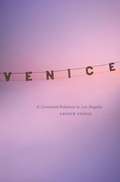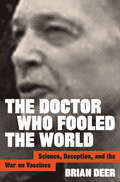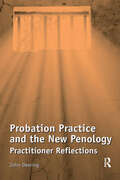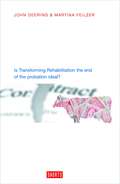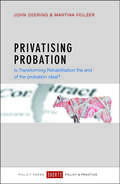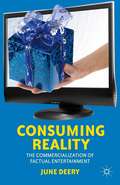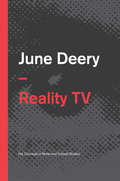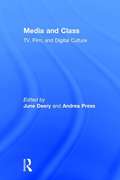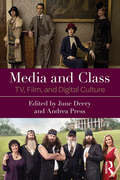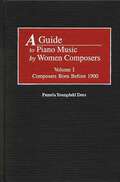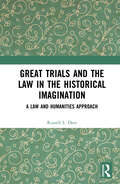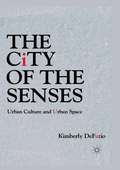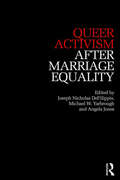- Table View
- List View
Venice: A Contested Bohemia in Los Angeles
by Andrew DeenerNestled between Santa Monica and Marina del Rey, Venice is a Los Angeles community filled with apparent contradictions. There, people of various races and classes live side by side, a population of astounding diversity bound together by geographic proximity. From street to street, and from block to block, million dollar homes stand near housing projects and homeless encampments; and upscale boutiques are just a short walk from the (in)famous Venice Beach where artists and carnival performers practice their crafts opposite cafés and ragtag tourist shops. In Venice: A Contested Bohemia in Los Angeles, Andrew Deener invites the reader on an ethnographic tour of this legendary California beach community and the people who live there. In writing this book, the ethnographer became an insider; Deener lived as a resident of Venice for close to six years. Here, he brings a scholarly eye to bear on the effects of gentrification, homelessness, segregation, and immigration on this community. Through stories from five different parts of Venice—Oakwood, Rose Avenue, the Boardwalk, the Canals, and Abbot Kinney Boulevard— Deener identifies why Venice maintained its diversity for so long and the social and political factors that threaten it. Drenched in the details of Venice’s transformation, the themes and explanations will resonate far beyond this one city. Deener reveals that Venice is not a single locale, but a collection of neighborhoods, each with its own identity and conflicts—and he provides a cultural map infinitely more useful than one that merely shows streets and intersections. Deener's Venice appears on these pages fully fleshed out and populated with a stunning array of people. Though the character of any neighborhood is transient, Deener's work is indelible and this book will be studied for years to come by scholars across the social sciences.
Venice: A Contested Bohemia in Los Angeles
by Andrew DeenerNestled between Santa Monica and Marina del Rey, Venice is a Los Angeles community filled with apparent contradictions. There, people of various races and classes live side by side, a population of astounding diversity bound together by geographic proximity. From street to street, and from block to block, million dollar homes stand near housing projects and homeless encampments; and upscale boutiques are just a short walk from the (in)famous Venice Beach where artists and carnival performers practice their crafts opposite cafés and ragtag tourist shops. In Venice: A Contested Bohemia in Los Angeles, Andrew Deener invites the reader on an ethnographic tour of this legendary California beach community and the people who live there. In writing this book, the ethnographer became an insider; Deener lived as a resident of Venice for close to six years. Here, he brings a scholarly eye to bear on the effects of gentrification, homelessness, segregation, and immigration on this community. Through stories from five different parts of Venice—Oakwood, Rose Avenue, the Boardwalk, the Canals, and Abbot Kinney Boulevard— Deener identifies why Venice maintained its diversity for so long and the social and political factors that threaten it. Drenched in the details of Venice’s transformation, the themes and explanations will resonate far beyond this one city. Deener reveals that Venice is not a single locale, but a collection of neighborhoods, each with its own identity and conflicts—and he provides a cultural map infinitely more useful than one that merely shows streets and intersections. Deener's Venice appears on these pages fully fleshed out and populated with a stunning array of people. Though the character of any neighborhood is transient, Deener's work is indelible and this book will be studied for years to come by scholars across the social sciences.
Venice: A Contested Bohemia in Los Angeles
by Andrew DeenerNestled between Santa Monica and Marina del Rey, Venice is a Los Angeles community filled with apparent contradictions. There, people of various races and classes live side by side, a population of astounding diversity bound together by geographic proximity. From street to street, and from block to block, million dollar homes stand near housing projects and homeless encampments; and upscale boutiques are just a short walk from the (in)famous Venice Beach where artists and carnival performers practice their crafts opposite cafés and ragtag tourist shops. In Venice: A Contested Bohemia in Los Angeles, Andrew Deener invites the reader on an ethnographic tour of this legendary California beach community and the people who live there. In writing this book, the ethnographer became an insider; Deener lived as a resident of Venice for close to six years. Here, he brings a scholarly eye to bear on the effects of gentrification, homelessness, segregation, and immigration on this community. Through stories from five different parts of Venice—Oakwood, Rose Avenue, the Boardwalk, the Canals, and Abbot Kinney Boulevard— Deener identifies why Venice maintained its diversity for so long and the social and political factors that threaten it. Drenched in the details of Venice’s transformation, the themes and explanations will resonate far beyond this one city. Deener reveals that Venice is not a single locale, but a collection of neighborhoods, each with its own identity and conflicts—and he provides a cultural map infinitely more useful than one that merely shows streets and intersections. Deener's Venice appears on these pages fully fleshed out and populated with a stunning array of people. Though the character of any neighborhood is transient, Deener's work is indelible and this book will be studied for years to come by scholars across the social sciences.
Venice: A Contested Bohemia in Los Angeles
by Andrew DeenerNestled between Santa Monica and Marina del Rey, Venice is a Los Angeles community filled with apparent contradictions. There, people of various races and classes live side by side, a population of astounding diversity bound together by geographic proximity. From street to street, and from block to block, million dollar homes stand near housing projects and homeless encampments; and upscale boutiques are just a short walk from the (in)famous Venice Beach where artists and carnival performers practice their crafts opposite cafés and ragtag tourist shops. In Venice: A Contested Bohemia in Los Angeles, Andrew Deener invites the reader on an ethnographic tour of this legendary California beach community and the people who live there. In writing this book, the ethnographer became an insider; Deener lived as a resident of Venice for close to six years. Here, he brings a scholarly eye to bear on the effects of gentrification, homelessness, segregation, and immigration on this community. Through stories from five different parts of Venice—Oakwood, Rose Avenue, the Boardwalk, the Canals, and Abbot Kinney Boulevard— Deener identifies why Venice maintained its diversity for so long and the social and political factors that threaten it. Drenched in the details of Venice’s transformation, the themes and explanations will resonate far beyond this one city. Deener reveals that Venice is not a single locale, but a collection of neighborhoods, each with its own identity and conflicts—and he provides a cultural map infinitely more useful than one that merely shows streets and intersections. Deener's Venice appears on these pages fully fleshed out and populated with a stunning array of people. Though the character of any neighborhood is transient, Deener's work is indelible and this book will be studied for years to come by scholars across the social sciences.
Venice: A Contested Bohemia in Los Angeles
by Andrew DeenerNestled between Santa Monica and Marina del Rey, Venice is a Los Angeles community filled with apparent contradictions. There, people of various races and classes live side by side, a population of astounding diversity bound together by geographic proximity. From street to street, and from block to block, million dollar homes stand near housing projects and homeless encampments; and upscale boutiques are just a short walk from the (in)famous Venice Beach where artists and carnival performers practice their crafts opposite cafés and ragtag tourist shops. In Venice: A Contested Bohemia in Los Angeles, Andrew Deener invites the reader on an ethnographic tour of this legendary California beach community and the people who live there. In writing this book, the ethnographer became an insider; Deener lived as a resident of Venice for close to six years. Here, he brings a scholarly eye to bear on the effects of gentrification, homelessness, segregation, and immigration on this community. Through stories from five different parts of Venice—Oakwood, Rose Avenue, the Boardwalk, the Canals, and Abbot Kinney Boulevard— Deener identifies why Venice maintained its diversity for so long and the social and political factors that threaten it. Drenched in the details of Venice’s transformation, the themes and explanations will resonate far beyond this one city. Deener reveals that Venice is not a single locale, but a collection of neighborhoods, each with its own identity and conflicts—and he provides a cultural map infinitely more useful than one that merely shows streets and intersections. Deener's Venice appears on these pages fully fleshed out and populated with a stunning array of people. Though the character of any neighborhood is transient, Deener's work is indelible and this book will be studied for years to come by scholars across the social sciences.
Venice: A Contested Bohemia in Los Angeles
by Andrew DeenerNestled between Santa Monica and Marina del Rey, Venice is a Los Angeles community filled with apparent contradictions. There, people of various races and classes live side by side, a population of astounding diversity bound together by geographic proximity. From street to street, and from block to block, million dollar homes stand near housing projects and homeless encampments; and upscale boutiques are just a short walk from the (in)famous Venice Beach where artists and carnival performers practice their crafts opposite cafés and ragtag tourist shops. In Venice: A Contested Bohemia in Los Angeles, Andrew Deener invites the reader on an ethnographic tour of this legendary California beach community and the people who live there. In writing this book, the ethnographer became an insider; Deener lived as a resident of Venice for close to six years. Here, he brings a scholarly eye to bear on the effects of gentrification, homelessness, segregation, and immigration on this community. Through stories from five different parts of Venice—Oakwood, Rose Avenue, the Boardwalk, the Canals, and Abbot Kinney Boulevard— Deener identifies why Venice maintained its diversity for so long and the social and political factors that threaten it. Drenched in the details of Venice’s transformation, the themes and explanations will resonate far beyond this one city. Deener reveals that Venice is not a single locale, but a collection of neighborhoods, each with its own identity and conflicts—and he provides a cultural map infinitely more useful than one that merely shows streets and intersections. Deener's Venice appears on these pages fully fleshed out and populated with a stunning array of people. Though the character of any neighborhood is transient, Deener's work is indelible and this book will be studied for years to come by scholars across the social sciences.
The Doctor Who Fooled the World: Science, Deception, and the War on Vaccines
by Brian DeerFrom San Francisco to Shanghai, from Vancouver to Venice, controversy over vaccines is erupting around the globe. Fear is spreading. Banished diseases have returned. And a militant "anti-vax" movement has surfaced to campaign against children's shots.But why?In The Doctor Who Fooled the World, award-winning investigative reporter Brian Deer exposes the truth behind the crisis. Writing with the page-turning tension of a detective story, he unmasks the players and unearths the facts. Where it began. Who was responsible. How they pulled it off. Who paid.At the heart of this dark narrative is the rise of the so-called "father of the anti-vaccine movement": a British-born doctor, Andrew Wakefield. Banned from medicine, thanks to Deer's discoveries, he fled to the United States to pursue his ambitions, and now claims to be winning a "war."In an epic investigation spread across fifteen years, Deer battles medical secrecy and insider cover-ups, smear campaigns and gagging lawsuits, to uncover rigged research and moneymaking schemes, the heartbreaking plight of families struggling with disability, and the scientific scandal of our time.
The Doctor Who Fooled the World: Science, Deception, and the War on Vaccines
by Brian DeerFrom San Francisco to Shanghai, from Vancouver to Venice, controversy over vaccines is erupting around the globe. Fear is spreading. Banished diseases have returned. And a militant "anti-vax" movement has surfaced to campaign against children's shots.But why?In The Doctor Who Fooled the World, award-winning investigative reporter Brian Deer exposes the truth behind the crisis. Writing with the page-turning tension of a detective story, he unmasks the players and unearths the facts. Where it began. Who was responsible. How they pulled it off. Who paid.At the heart of this dark narrative is the rise of the so-called "father of the anti-vaccine movement": a British-born doctor, Andrew Wakefield. Banned from medicine, thanks to Deer's discoveries, he fled to the United States to pursue his ambitions, and now claims to be winning a "war."In an epic investigation spread across fifteen years, Deer battles medical secrecy and insider cover-ups, smear campaigns and gagging lawsuits, to uncover rigged research and moneymaking schemes, the heartbreaking plight of families struggling with disability, and the scientific scandal of our time.
Probation Practice and the New Penology: Practitioner Reflections
by John DeeringThe criminal justice system has been in a state of flux in recent decades, accompanied by growing levels of insecurity and intolerance of crime and offenders among the general population. Along with government policy and practice, these developments are seen as contributing to an increasingly punitive system that imprisons more than ever before and seeks to punish and manage offenders in the community, rather than to attempt their rehabilitation. For these reasons, along with a loss of faith in rehabilitation, the probation service is now described by many as having become a law enforcement agency, charged by government with the assessment and management of risk, the protection of the public and the management and punishment of offenders, rather than their transformation into pro-social citizens. This book explores the extent to which practitioners within the National Probation Service for England and Wales and the National Offender Management Service ascribe to the values, attitudes and beliefs associated with these macro and mezzo level changes and how much their practice has changed accordingly. By viewing examples of 'real' practice through the lens of the modernisation of public services, managerialism and theories of organisation change, the book considers how 'real' practice is likely to emerge as something unpredictable and perhaps different from the intentions of both government/management and practitioners.
Probation Practice and the New Penology: Practitioner Reflections
by John DeeringThe criminal justice system has been in a state of flux in recent decades, accompanied by growing levels of insecurity and intolerance of crime and offenders among the general population. Along with government policy and practice, these developments are seen as contributing to an increasingly punitive system that imprisons more than ever before and seeks to punish and manage offenders in the community, rather than to attempt their rehabilitation. For these reasons, along with a loss of faith in rehabilitation, the probation service is now described by many as having become a law enforcement agency, charged by government with the assessment and management of risk, the protection of the public and the management and punishment of offenders, rather than their transformation into pro-social citizens. This book explores the extent to which practitioners within the National Probation Service for England and Wales and the National Offender Management Service ascribe to the values, attitudes and beliefs associated with these macro and mezzo level changes and how much their practice has changed accordingly. By viewing examples of 'real' practice through the lens of the modernisation of public services, managerialism and theories of organisation change, the book considers how 'real' practice is likely to emerge as something unpredictable and perhaps different from the intentions of both government/management and practitioners.
Privatising Probation: Is Transforming Rehabilitation The End Of The Probation Ideal? (PDF)
by John Deering Martina FeilzerOver the past 20 years, there have been many changes to probation governance in England and Wales aimed at controlling it from central government. However, the changes introduced under the Transforming Rehabilitation (TR) agenda, introduced in 2013, are unprecedented: the service has been divided and part-privatised and no longer exists as a unified public body. This topical book looks at the attitudes of probation practitioners and managers to the philosophy, values, and practicalities of TR. Based on a unique online survey of over 1300 respondents which found that they were unequivocally opposed to its broad aims and objectives, it provides unique insights into the values, attitudes and beliefs of probation staff and their delivery of services. Including broader discussion of the privatisation/marketisation debate, the context of privatisation of criminal justice services and questions of legitimacy and governance, this is essential reading for everyone interested in the future of the service.
Privatising probation: Is Transforming Rehabilitation the end of the probation ideal?
by John Deering Martina FeilzerOver the past 20 years, there have been many changes to probation governance in England and Wales aimed at controlling it from central government. However, the changes introduced under the Transforming Rehabilitation (TR) agenda, introduced in 2013, are unprecedented: the service has been divided and part-privatised and no longer exists as a unified public body. This topical book looks at the attitudes of probation practitioners and managers to the philosophy, values, and practicalities of TR. Based on a unique online survey of over 1300 respondents which found that they were unequivocally opposed to its broad aims and objectives, it provides unique insights into the values, attitudes and beliefs of probation staff and their delivery of services. Including broader discussion of the privatisation/marketisation debate, the context of privatisation of criminal justice services and questions of legitimacy and governance, this is essential reading for everyone interested in the future of the service.
Privatising probation: Is Transforming Rehabilitation the end of the probation ideal?
by John Deering Martina FeilzerOver the past 20 years, there have been many changes to probation governance in England and Wales aimed at controlling it from central government. However, the changes introduced under the Transforming Rehabilitation (TR) agenda, introduced in 2013, are unprecedented: the service has been divided and part-privatised and no longer exists as a unified public body. This topical book looks at the attitudes of probation practitioners and managers to the philosophy, values, and practicalities of TR. Based on a unique online survey of over 1300 respondents which found that they were unequivocally opposed to its broad aims and objectives, it provides unique insights into the values, attitudes and beliefs of probation staff and their delivery of services. Including broader discussion of the privatisation/marketisation debate, the context of privatisation of criminal justice services and questions of legitimacy and governance, this is essential reading for everyone interested in the future of the service.
Privatising Probation: Is Transforming Rehabilitation The End Of The Probation Ideal? (PDF)
by John Deering Martina FeilzerOver the past 20 years, there have been many changes to probation governance in England and Wales aimed at controlling it from central government. However, the changes introduced under the Transforming Rehabilitation (TR) agenda, introduced in 2013, are unprecedented: the service has been divided and part-privatised and no longer exists as a unified public body. This topical book looks at the attitudes of probation practitioners and managers to the philosophy, values, and practicalities of TR. Based on a unique online survey of over 1300 respondents which found that they were unequivocally opposed to its broad aims and objectives, it provides unique insights into the values, attitudes and beliefs of probation staff and their delivery of services. Including broader discussion of the privatisation/marketisation debate, the context of privatisation of criminal justice services and questions of legitimacy and governance, this is essential reading for everyone interested in the future of the service.
Consuming Reality: The Commercialization of Factual Entertainment
by J. DeeryEngaging in a comprehensive examination of reality TV's advertising and promotional strategies, as well as the commodification of viewers, Consuming Reality dissects the unique and startling relation between mediation and consumption.
Reality TV (Key Concepts in Media and Cultural Studies)
by June DeeryReality TV has changed television and changed reality, even if we are not among the millions who watch. Written for a broad audience, this accessible overview addresses questions such as: How real is reality TV? How do its programs represent gender, sex, class, and race? How does reality TV relate to politics, to consumer society, to surveillance? What kind of ethics are on display? Drawing on current media research and the author’s own analysis, this study encompasses the history and evolution of reality television, its production of reflexive selves and ordinary celebrity, its advertising and commercialization, and its spearheading of new relations between television and social media. To dismiss this programming as trivial is easy. Deery demonstrates that reality television merits serious attention and her incisive analysis will interest students in media studies, cultural studies, politics, sociology, and anyone who is simply curious about this global phenomenon.
Media and Class: TV, Film, and Digital Culture (PDF)
by June Deery Andrea PressAlthough the idea of class is again becoming politically and culturally charged, the relationship between media and class remains understudied. This diverse collection draws together prominent and emerging media scholars to offer readers a much-needed orientation within the wider categories of media, class, and politics in Britain, America, and beyond. Case studies address media representations and media participation in a variety of platforms, with attention to contemporary culture: from celetoids to selfies, Downton Abbey to Duck Dynasty, and royals to reality TV. These scholarly but accessible accounts draw on both theory and empirical research to demonstrate how different media navigate and negotiate, caricature and essentialize, or contain and regulate class.
Media and Class: TV, Film, and Digital Culture
by June Deery Andrea PressAlthough the idea of class is again becoming politically and culturally charged, the relationship between media and class remains understudied. This diverse collection draws together prominent and emerging media scholars to offer readers a much-needed orientation within the wider categories of media, class, and politics in Britain, America, and beyond. Case studies address media representations and media participation in a variety of platforms, with attention to contemporary culture: from celetoids to selfies, Downton Abbey to Duck Dynasty, and royals to reality TV. These scholarly but accessible accounts draw on both theory and empirical research to demonstrate how different media navigate and negotiate, caricature and essentialize, or contain and regulate class.
Media and Class: TV, Film, and Digital Culture (Feminist Cultural Studies, The Media, And Political Culture Ser.)
by June Deery Andrea PressAlthough the idea of class is again becoming politically and culturally charged, the relationship between media and class remains understudied. This diverse collection draws together prominent and emerging media scholars to offer readers a much-needed orientation within the wider categories of media, class, and politics in Britain, America, and beyond. Case studies address media representations and media participation in a variety of platforms, with attention to contemporary culture: from celetoids to selfies, Downton Abbey to Duck Dynasty, and royals to reality TV. These scholarly but accessible accounts draw on both theory and empirical research to demonstrate how different media navigate and negotiate, caricature and essentialize, or contain and regulate class.
A Guide to Piano Music by Women Composers: Volume One, Composers Born Before 1900 (Music Reference Collection)
by Pamela Y. DeesDesigned as a practical reference guide for professional pianists and piano teachers, A Guide to Piano Music by Women Composers, Volume I, is an annotated catalogue of the available piano music in print composed by 144 women born before the 20th century. The work also features biographies and extensive bibliographical information for each composer. Arranged alphabetically by composer into categories including single works, collections, and anthologies, the music is also described in terms of grade level, genre, mood, style characteristics, and technical requirements, and ranges in difficulty from late elementary to virtuoso concert repertoire.Far too many teachers, students, professional musicians, and audiences are unaware of the contributions made by women in music, and of the beauty and merit of their specific compositions. This reference work provides an invaluable addition to the current literature.
Great Trials and the Law in the Historical Imagination: A Law and Humanities Approach
by Russell L. DeesGreat Trials and the Law in the Historical Imagination: A Law and Humanities Approach introduces readers to the history of law and issues in historical, legal, and artistic interpretation by examining six well-known historical trials through works of art that portray them. Great Trials provides readers with an accessible, non-dogmatic introduction to the interdisciplinary ‘law and humanities’ approach to law, legal history, and legal interpretation. By examining how six famous/notorious trials in Western history have been portrayed in six major works of art, the book shows how issues of legal, historical, and artistic interpretation can become intertwined: the different ways we embed law in narrative, how we bring conscious and subconscious conceptions of history to our interpretation of law, and how aesthetic predilections and moral commitments to the law may influence our views of history. The book studies well-known depictions of the trials of Socrates, Cicero, Jesus, Thomas More, the Salem ‘witches’, and John Scopes and provides innovative analyses of those works. The epilogue examines how historical methodology and historical imagination are crucial to both our understanding of the law and our aesthetic choices through various readings of Harper Lee’s beloved character, Atticus Finch. The first book to employ a ‘law and humanities’ approach to delve into the institution of the trial, and what it means in different legal systems at different historical times, this book will appeal to academics, students and others with interests in legal history, law and popular culture and law and the humanities.
Great Trials and the Law in the Historical Imagination: A Law and Humanities Approach
by Russell L. DeesGreat Trials and the Law in the Historical Imagination: A Law and Humanities Approach introduces readers to the history of law and issues in historical, legal, and artistic interpretation by examining six well-known historical trials through works of art that portray them. Great Trials provides readers with an accessible, non-dogmatic introduction to the interdisciplinary ‘law and humanities’ approach to law, legal history, and legal interpretation. By examining how six famous/notorious trials in Western history have been portrayed in six major works of art, the book shows how issues of legal, historical, and artistic interpretation can become intertwined: the different ways we embed law in narrative, how we bring conscious and subconscious conceptions of history to our interpretation of law, and how aesthetic predilections and moral commitments to the law may influence our views of history. The book studies well-known depictions of the trials of Socrates, Cicero, Jesus, Thomas More, the Salem ‘witches’, and John Scopes and provides innovative analyses of those works. The epilogue examines how historical methodology and historical imagination are crucial to both our understanding of the law and our aesthetic choices through various readings of Harper Lee’s beloved character, Atticus Finch. The first book to employ a ‘law and humanities’ approach to delve into the institution of the trial, and what it means in different legal systems at different historical times, this book will appeal to academics, students and others with interests in legal history, law and popular culture and law and the humanities.
The City of the Senses: Urban Culture and Urban Space
by K. DeFazioOffers an innovative, interdisciplinary approach which opens up new ways of understanding urban culture and space. The author approaches the city as essentially a 'material' place where people live, work, and participate in social practices within historical limits set not by sensory experience or cultural meanings but material social conditions.
Queer Activism After Marriage Equality (After Marriage Equality)
by Joseph Nicholas DeFilippis Michael W. Yarbrough Angela JonesQueer Activism After Marriage Equality focuses on the implications of legal same-sex marriage for LGBTQ social movements and organizing. It asks how the agendas, strategies, structures and financing of LGBTQ movement organizations are changing now that same-sex marriage is legal in some countries. Building on a major conference held in 2016 entitled "After Marriage: The Future of LGBTQ Politics and Scholarship," this collection draws from critical and intersectional perspectives to explore the questions and issues facing the next chapter of LGBTQ activism and social movement work. It comprises academic papers, international case studies, edited transcripts of selected conference sessions, and interviews with activists. These take a critical look at the high-profile work of national and state-wide equality organizations, analyzing the costs of winning marriage equality and what that has meant for other LGBTQ activism. In addition to this, the book examines other forms of queer activism that have existed for years in the shadows of the marriage equality movement, as well as new social movements that have developed more recently. Finally, it looks to examples of activism in other countries and considers lessons U.S. activists can learn from them. By presenting research on these and other trends, this volume helps translate queer critiques advanced during the marriage campaigns into a framework for ongoing critical research in the after-marriage period.
Queer Activism After Marriage Equality (After Marriage Equality)
by Joseph Nicholas DeFilippis Michael W. Yarbrough Angela JonesQueer Activism After Marriage Equality focuses on the implications of legal same-sex marriage for LGBTQ social movements and organizing. It asks how the agendas, strategies, structures and financing of LGBTQ movement organizations are changing now that same-sex marriage is legal in some countries. Building on a major conference held in 2016 entitled "After Marriage: The Future of LGBTQ Politics and Scholarship," this collection draws from critical and intersectional perspectives to explore the questions and issues facing the next chapter of LGBTQ activism and social movement work. It comprises academic papers, international case studies, edited transcripts of selected conference sessions, and interviews with activists. These take a critical look at the high-profile work of national and state-wide equality organizations, analyzing the costs of winning marriage equality and what that has meant for other LGBTQ activism. In addition to this, the book examines other forms of queer activism that have existed for years in the shadows of the marriage equality movement, as well as new social movements that have developed more recently. Finally, it looks to examples of activism in other countries and considers lessons U.S. activists can learn from them. By presenting research on these and other trends, this volume helps translate queer critiques advanced during the marriage campaigns into a framework for ongoing critical research in the after-marriage period.
